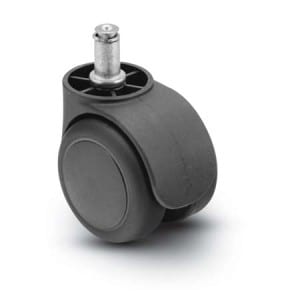
Casters are the best way to get seemingly immovable objects mobile again. If you have a useful piece of medical equipment that needs to be moved around, then all you need to do is adhere casters to the bottom of it and mobility is achieved!
That’s the positive aspect of a caster – the negative is that caster-mounted objects can sometimes seemingly have a life of their own and are reluctant to stay in one place – especially if they are resting on non-level floors. Additionally, if a caster-mounted item is heavy, it can sometimes become difficult to maneuver.
The Solution: Casters with Brakes
The solution to this over-mobility problem is of course, the humble brake. A brake on a caster performs the same function as a brake on any other wheeled device – to prevent or lessen traction or to prevent movement altogether.
When it comes to caster brakes, there are two main options – compression brakes and decompression brakes.
How a Compression Brake Works
You might like to think of a compression brake as a kind of measuring scale – the old-style sprung ones with a platform on top and a dial on front. The more pressure that is applied to the platform, the further the pointer spins around the dial.
A compression brake works in very much the same manner – without the dial of course. The brake is sprung to provide resistance, and that resistance is countered by the weight that the caster supports. Once the weight is enough to totally negate the resistance, the brake is triggered, locking the caster into place and so preventing mobility.
Compression brakes can be fitted to both fixed and swivel brakes, and in the latter case the swivel motion is locked as well as the linear motion. To m
ove a caster-mounted item that is locked by compression brakes you simply have to lift the object slightly in order to prevent the object’s weight from triggering the brake.
How a Decompression Brake Works
As you might imagine, a decompression brake works in entirely the opposite way as a compression brake. Normally, an item fitted with compression brakes cannot be moved as there is not enough weight to counter the necessary resistance. Once weight is applied, then the brakes unlock and the casters become mobile.
This is useful when a caster-mounted platform is used to move other objects. While the platform is not loaded, it will remain stationary. However, once sufficient weight has been placed on the platform, it can then be moved around. Once the load is removed, the platform becomes immobile again. This mechanism is designed to make caster-mounted platforms and other items safe to load and use, as they will not move about while being loaded.
There are plenty of casters that our team at Douglas Equipment can supply you with, and many of the models supplied by top manufacturers such as Shepherd and Colson Casters can be supplied fitted with either compression or decompression brakes.
Douglas Equipment: Helping You Find the Right Caster
To find the perfect caster for your operation, simply contact us to speak to one of our staff members. Call us at 1-800-451-0030, or as an alternative use the online contact form that’s available on our website.




